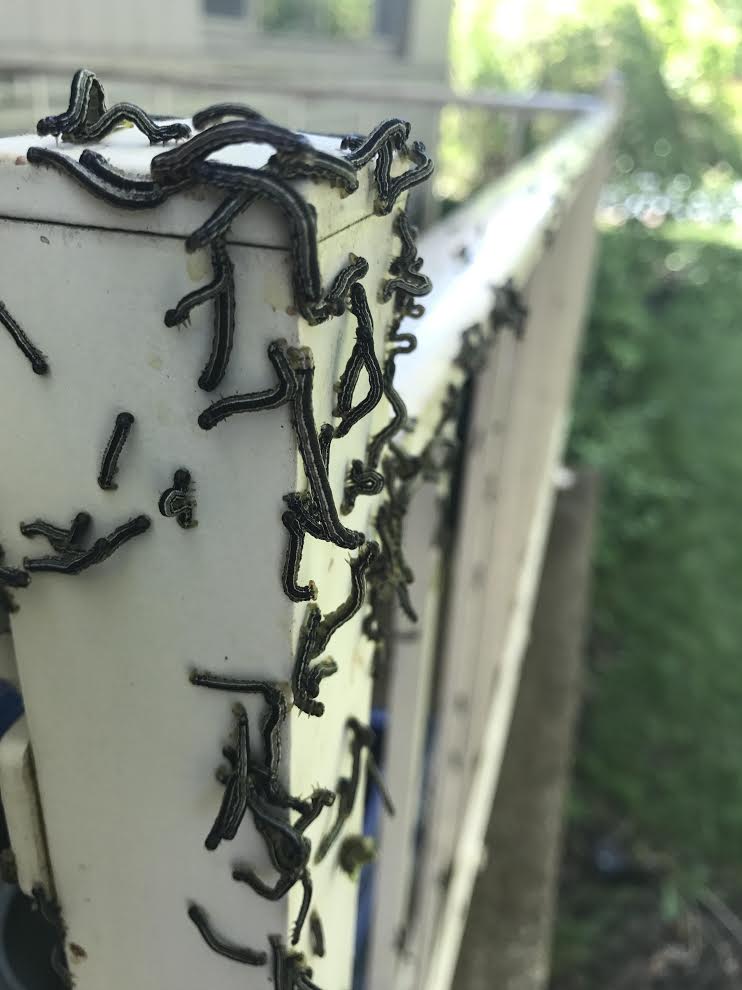The Cankerworm Invasion of the University College Hospital

Until much recently, the only time I had come across “cankerworms” was when Joel 2:25 was read at church, and in the prayers that followed the reading – “Lord restore to me the years the cankerworm and caterpillars have eaten”. However, to my surprise and horror, cankerworms have become reality in the University College Hospital, and I hear the University of Ibadan as well. If you live within the University College Hospital, or the University of Ibadan, you may have recently come across some black little creepies that seem to double faster than Burkitt’s lymphoma, and have the tendency to make the hairs on your skin stand for bad reasons. If you haven’t, well, thank your stars, but rest assured you may run into them soon.
Cankerworms, also known as inchworms, spanworms or loopers, are tiny caterpillars that essentially move by looping. If you, like me, have wondered just why they move the way they do, it is because they do not have legs in the middle. They have three pairs of legs in front and two or three pairs of legs in the back, and so they move their front legs, create a loop with their legless centre, and then move their hind legs. This is why they are called inchworms, because it as though they are measuring inch by inch. This reminds me of when I thought I would measure long distance with my feet and would also go feet by feet. I found it to be a rather draining and not quite accurate venture, but I digress.
Loopers, much like Yoruba demons, cannot seem to choose one moth they want to become and stick to it. They are larvae of several different species of geometrid moths. Hence, when they all mature, they do not all look the same. Rather, they morph into different colourful species of geometrid moths. The two most common inchworms are the spring inchworms (Paleacrita vernata) and the fall inchworms (Alsophila pometaria). Don’t worry if they do not sound familiar, I also did 6 Zoology courses in 100L and they did not ring a bell.
The spring and fall cankerworms are not just the commonest, but are also the most destructive set of loopers. Paleacrita vernata are the ones with two pairs of hind legs. They come in different colours from red, to green, yellowish brown, or black, and they have a pale yellow stripe on either side. Alsophila pometaria on the other hand, have three pairs of hind legs, can be light green or black, and have three pale yellow stripes on either side. Which do we have in UCH? I was tempted to ask you to go find out but I have taken the liberty to carefully observe the inchworms, amidst protests from my skin, and I have good reason to believe that we are afflicted with the fall inchworms.

If you are like me, the first thing you probably wondered about when you saw them was if they are poisonous. I mean, I had never seen them around and suddenly there were a lot of them. I had good reason to worry. Thankfully, they are not toxic to humans. They feed on plants and favour deciduous trees, which is probably why they are concentrated at the “mini-forest” beside UBA. The sad thing though, is that they are destroying our trees rapidly. While I know that we are still learning to be enviroment-friendly in these parts, you may want to be worried about this as the cankerworms can defoliate several trees in a very short while.

How do the little cankerworms come to be? According to Pets on Mom, adult moths usually breed among the foliage on the forest floor. The female moths do not have wings, so they climb the trees and lay egg masses on the tree branches. After the eggs hatch, the baby cankerworms go through four larval stages during which they eat every minute, constantly munching on leaves. Within four to six weeks, they are ready to be unleashed, and so they fall to the ground on silk strands. That is why you may have seen them hanging from silk threads before they drop. You also may wonder why they are so many. Well, each egg mass contains 100 to 250 eggs, so if there are several egg masses, you can do the math. When they drop to the ground, they burrow into the ground and create hibernation chambers where they go through the pupal stage and then grow to become adults. Adult Alsophila pometaria emerge during the late fall rains and frost. Adult Paleacrita vernata emerge around February, in late winter.
Why are they suddenly in UCH and UI? That is a question I am yet to get an answer to. If you find out, I will be more than happy to learn from you. Inchworm infestations are best controlled with the use of pesticides, and preferably with aerial spraying of the trees. However, I do not know if this sudden infestation is of enough concern to the University of Ibadan and the University College Hospital communities, to have them take drastic steps to control them, so I guess we will have to wait and see.

They make me sick
They make my skin crawl as well, and they multiply so fast.
This is very well written and quite informative too!
Thank you, Nike.